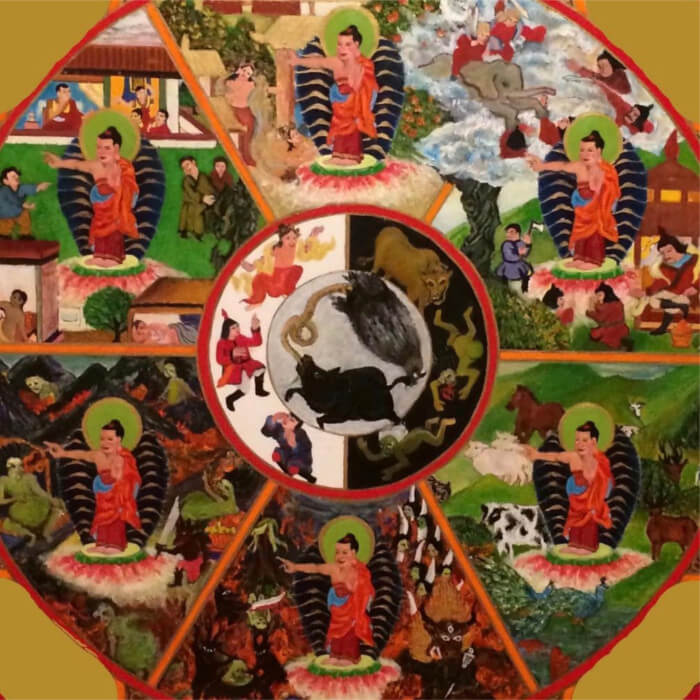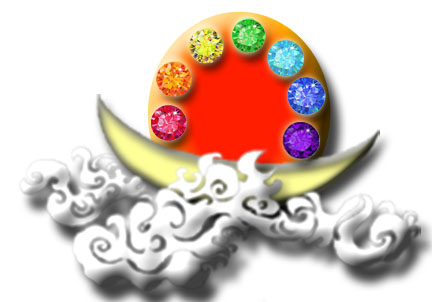
At our class last week someone asked about the various heavens and hells as expressed in Buddhist cosmology. Some aspects are similar to concepts in other religions, but some are different. The system has a place for the Christian, Taoist, and Hindu heavens. I can see where the Greek and Roman gods would fit, although that is not specified. Use the right arrow on your laptop and your finger on your phone or tablet to scroll to the right to view the characteristics of various levels within these realms. The chart also indicates the major causes of rebirth in each of these realms. Additional links to other articles on the Six Realms and the above painting are listed below.
| Realms and sub-Realms | Causes of Rebirth here | Characteristics |
| Heavens within the Formless & Form Realms: | ||
| FORMLESS REALM (arupaloka) | ||
| Accessible to those who pass away while meditating in the formless jhanas | The inhabitants of these realms are possessed entirely of consciousness. Having no physical body, they are unable to hear Dharma teachings. | |
| Neither-perception-nor-non-perception (nevasaññanasaññayatanupaga deva) | Fourth formless jhanas | |
| Nothingness (akiñcaññayatanupaga deva) | Third formless jhanas | |
| Infinite Consciousness (viññanañcayatanupaga deva) | Second formless jhanas | |
| Infinite Space (akasanañcayatanupaga deva) | First formless jhanas | |
FORM REALM (ripaloka) | ||
Peerless devas (akanittha deva) Clearsighted devas (sudassi deva) Beautiful devas (sudassa deva) Untroubled devas (atappa deva) Devas Not Falling Away (aviha deva) | Fourth jhana | These are the five Pure Abodes (suddhavasa), which are accessible only to non- returners (anagami) and arhats. Beings who become non- returners in other planes are reborn here, where they attain arhatship. Among its inhabitants is Brahma Sahampati, who begs the Buddha to teach Dharma to the world. |
| Unconscious beings (asaññasatta) | Fourth jhana | Only body is present; no mind or consciousness. Not included in all classification systems. |
| Very Fruitful devas (vehapphala deva) | Fourth jhana | |
| Devas of Refulgent Glory or Pervasive Purity (subhakinna deva) Devas of Unbounded Glory or Limitless Purity (appamanasubha deva) Devas of Limited Glory or Lesser Purity (parittasubha deva) | Third jhana | |
| Devas of Streaming Radiance or Light-Sound Heaven (abhassara deva) Devas of Unbounded Radiance or Limitless Light (appamanabha deva) Devas of Limited Radiance or Lesser Light (parittabha deva) | Second jhana | |
| Great Brahmas (Maha brahma) Ministers of Brahma (brahma-purohita deva) Retinue or Multitudes of Brahma (brahma-parisajja deva) | First jhana | |
| DESIRE REALM (kamaloka) | ||
| Six Heavens within the Desire Realm: | ||
| Devas Wielding Power over the Creation of Others (paranimmita-vasavatti deva) | Ten Good Characteristics | These devas enjoy sense pleasures created by others for them. Mara, the personification of delusion and desire, lives here. |
| Devas Delighting in Creation (nimmanarati deva) | Ten Good Characteristics | These devas delight in the sense objects of their own creation. |
| Contented devas (tusita deva) | Ten Good Characteristics | A realm of pure delight and gaiety. Bodhisattas abide here prior to their final human birth. This is where the Maitreya Bodhisatta, the next Buddha, dwells. |
| Yama devas-Suyama Heavens (yama deva) | Ten Good Characteristics | These devas live in the air, free of all difficulties. |
| The Thirty-three Gods (tavatimsa or trayastrimsha deva) | Ten Good Characteristics | Sakra (Indra), a devotee of the Buddha, presides over this realm. Many devas dwelling here live in mansions in the air. |
| Devas of the Four Great Kings (catumaharajika deva) | Ten Good Characteristics | Home of the gandharvas, the celestial musicians, and the yaksas or tree spirits of varying degrees of ethical purity. The latter are analogous to the goblins, trolls, and fairies of Western fairy tales. |
| ASURAS (Demi-gods): | Ten Unwholesome Actions, lack of virtue, holding to wrong views | The demons — “titans” — that dwell here are engaged in relentless conflict with each other. Sometimes classified as part of the “lower or undesirable realms.” |
| HUMAN BEINGS (manussa loka): | Ten Good Characteristics | |
| ANIMALS (tiracchana yoni): | Ten Unwholesome Actions, lack of virtue, holding to wrong views | If one is generous to monks and nuns, however, one may be reborn as an “ornamented” animal (i.e., a bird with bright plumage; a horse with attractive markings, etc. that is fed and treated well. |
| HUNGRY SHADES/GHOSTS (peta loka) | Ten Unwholesome Actions, lack of virtue, holding to wrong views | Ghosts and unhappy spirits wander hopelessly about this realm, searching in vain for sensual fulfillment. |
| HELL BEINGS (nirya) | Ten Unwholesome Actions, lack of virtue, holding to wrong views | There are different ways the various hells (Narakas) are classified, but they are often described as 8 Hot and 8 Cold Hells that last for varying times. |
CLICK for more information on “The Wheel of Life” and its symbolism.
CLICK for more information on the nature of Samsara and an article on “Evil View #17: Acknowledging that transmigration within the six realms is a legend that is untrue.”



Thank you for this posting. My knowledge of the planes, or realms within the realms, is limited but now has expanded.